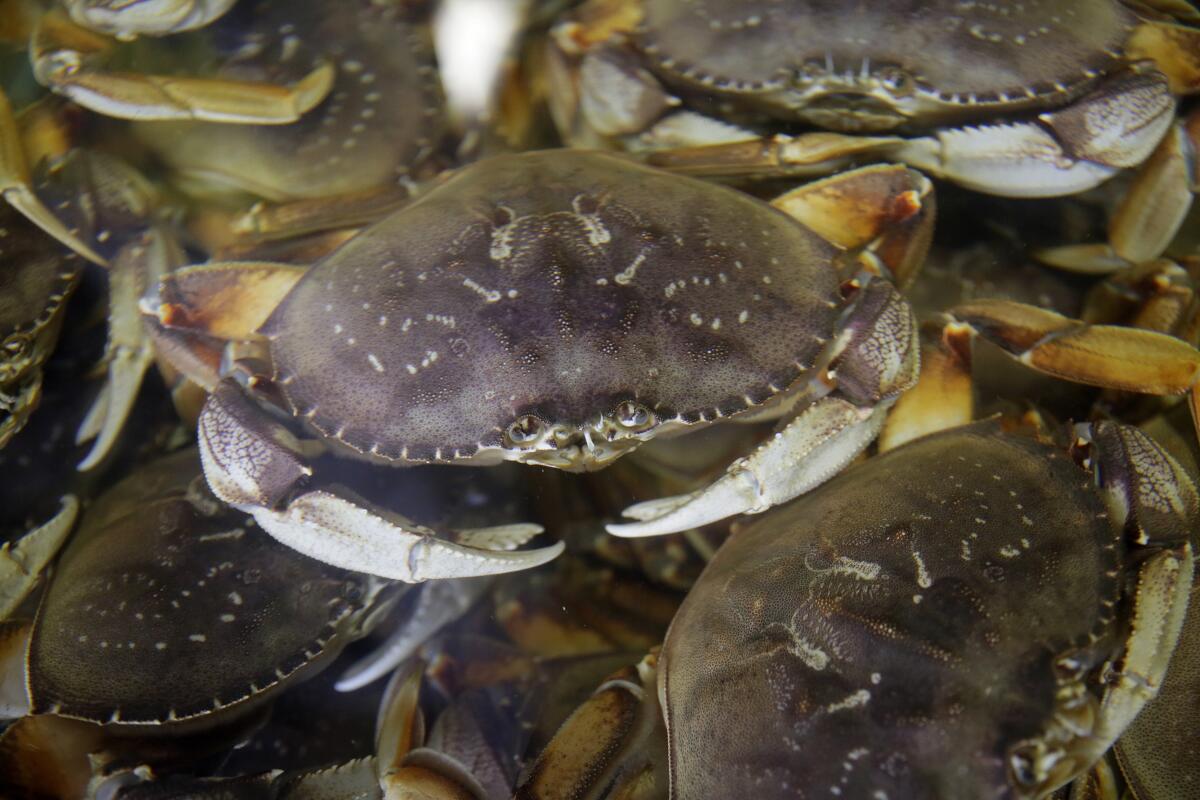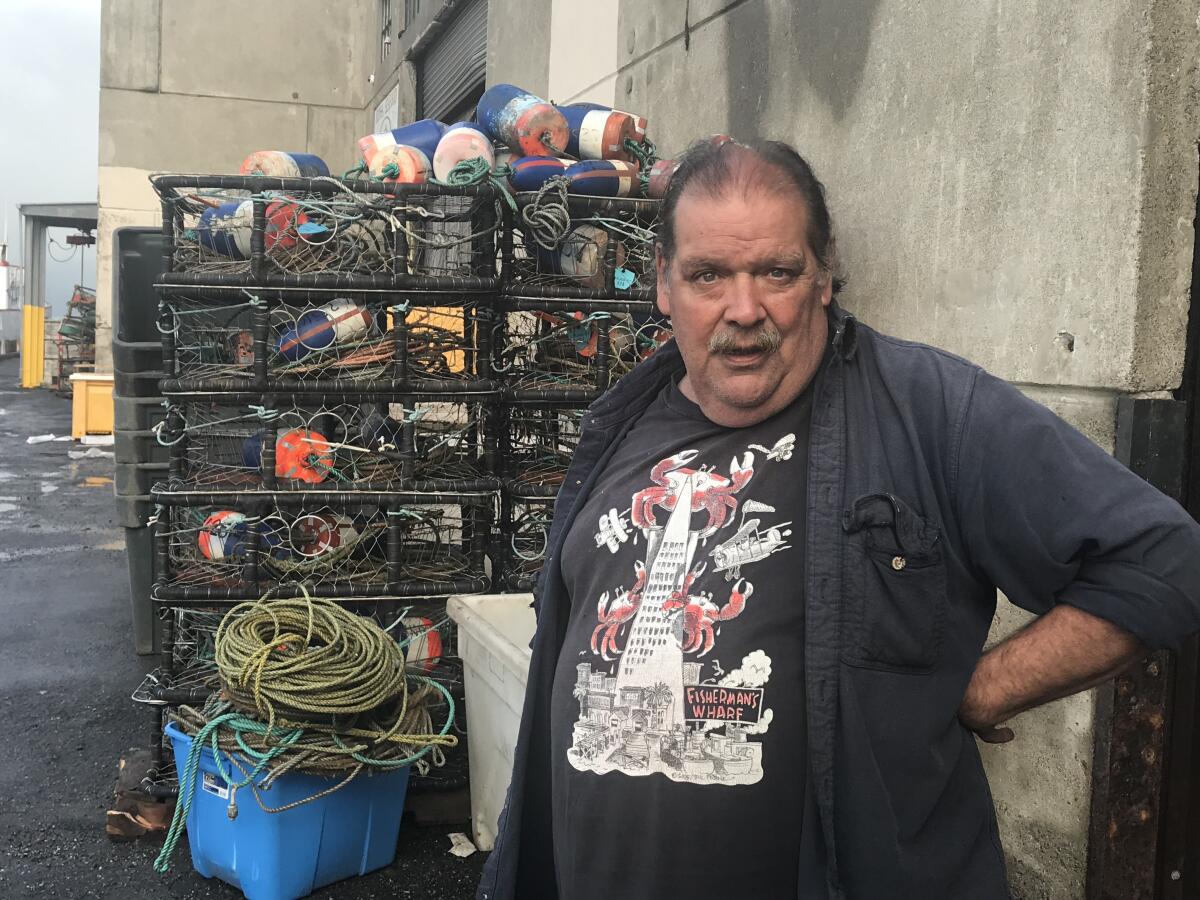Column: A California dilemma: Save the whales or eat the crabs?

- Share via
SAN FRANCISCO — In the early morning chill on Pier 45, Larry Collins and I sat in a cluttered wood-paneled trailer inside his cavernous fish receiving station. Outside, the fog was lifting over the Golden Gate Bridge to the west, and the sun was already shining on Alcatraz Island to the east.
Inside, a small TV was tuned to a news station; the talk was all about impeachment.
But Collins and I were talking about the only thing that mattered here right now, Dungeness crab.
“Two nights ago, I unloaded 45,000 pounds of crab from 14 vessels,” said Collins, 62, founder and president of the San Francisco Community Fishing Assn. “I was here for 24 hours.”
Dungeness crab has an unrivaled pull on the imaginations and taste buds of San Franciscans. For many, it is an essential part of the holiday season. Some families are so smitten with crab, Collins said, they eat it instead of turkey for Thanksgiving. “This crab here is the best crab in the world,” he said. “It’s buttery, it melts in your mouth. Absolutely fantastic.”
Traditionally, the four-month crab season opens on Nov. 15, but this year, it was delayed a month — a precious, money-losing month for the small community of crabbers that operates off the west side of Pier 45.

This was yet another blow to the fleet. Three of the last four seasons have been marred by a naturally occurring neurotoxin that can be fatal to humans. A newspaper cartoon on Collins’ wall commemorated the event; it shows a perplexed San Francisco family gathered at the Thanksgiving table trying to figure out how to crack open the turkey.
This year, the season was delayed by migrating whales.
Whales can get tangled in the slack of crabbers’ lines that rise to the surface from crab pots on the sea bed. Warmer waters bring whales closer to shore, where they risk potentially deadly entanglement.
I had always assumed Californians loved whales, and that measures to save the gigantic, federally protected creatures would be universally applauded. I was wrong.
“There are so many whales out there! When we stopped shooting them with exploding harpoon tips, the whale population started to increase,” Collins said.
Singling out the commercial crab fleet feels extremely unfair to Collins. After all, he said, ship strikes kill more whales than crab lines. “But we are the only ones paying for that!”
This will not endear me to the fishermen, but I, for one, am willing to have a shorter season and pay more for crab if it helps save even one whale. Three years ago, I traveled to San Ignacio Lagoon in Mexico to pet baby gray whales in the wild. It was one of the most magical experiences of my life. As my friend and traveling companion Alice Short wrote: “There are whale people — and then there’s the rest of the world.” I am a whale person.
Crabbing, as anyone who has watched “The Deadliest Catch” knows, is a perilous profession.
On Wednesday evening, in heavy weather, a 50-foot steel boat, the Mandy Jane, went down eight miles southwest of the Golden Gate Bridge. She was on her way to pick up crab pots. Fortunately, no lives were lost. A Coast Guard spokesman told me that all four crewman and the skipper had been picked up by one of the pilot boats that guide commercial ships under the Golden Gate Bridge into San Francisco Bay.
“It happens more than you want it to,” Collins said. Russell Deman, the Mandy Jane’s skipper, is one of his best friends.
This is one reason why Collins has no sympathy for people who complain about the cost of crab — crabbers are paid $3 a pound right now. “People say, ‘Oh, you only pay the boats that much, then why am I paying this much in a store?’ Well, it’s not enough,” said Collins. “The boats never get enough!”
So much has changed in San Francisco over the last two decades.
The tech industry has upended the city’s balance. There was always a gulf between rich and poor, but the digital revolution has deepened the divide, and parts of the city have become unbearable because there is so much suffering amid such plenty.
But there are some corners of the city where time seems to have stood still. Pier 45, the heart of the city’s shrunken fishing industry, is one of them.
I left Collins and walked along the west side of the pier, dodging piles of flaked ice, bits of crab claws and hungry seagulls. A Bodega Bay-based boat was tied up at the pier. Crabs skittered across its deck. The skipper and two hands appeared to be ripping up live crabs for a customer who was sticking the pieces in a plastic bag. I stopped to watch.
A short walk away, servers, cooks and bartenders were bustling around inside the venerable San Francisco fish house Scoma’s, getting ready for the lunch crowd. Chef Julian Sandoval told me he expected to sell 50 or 60 crabs.
There is no comparison between fresh crab and frozen, he says.
Fresh crab, he said, “is bigger, it’s meatier, it’s richer.”
In the bar, I chatted with Scoma’s president, Tom Creedon, 75, a former San Francisco firefighter who married into the Scoma family.
“At Fisherman’s Wharf,” he said, “the crab is so important to us that it’s our logo.”
Dungeness crab is the restaurant’s most popular menu item, and is so essential to the business that the restaurant has its own boat, which can carry 10,000 pounds of crab at a time.
“We always have cioppino on the menu,” he said, “but this time of year, they want to see the shells, they want to pick them and make a mess.”
His favorite way to eat crab this time of year, he said, is steamed, cracked, then finished in the oven with olive oil and garlic. “Just thinking about it is making me slobber,” he said.
Me too.
More to Read
A cure for the common opinion
Get thought-provoking perspectives with our weekly newsletter.
You may occasionally receive promotional content from the Los Angeles Times.











